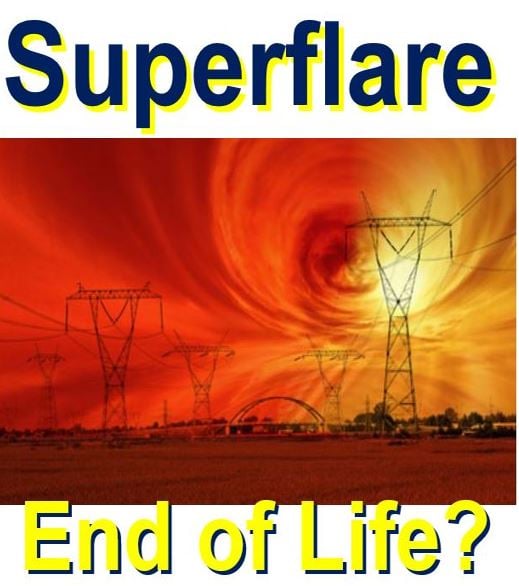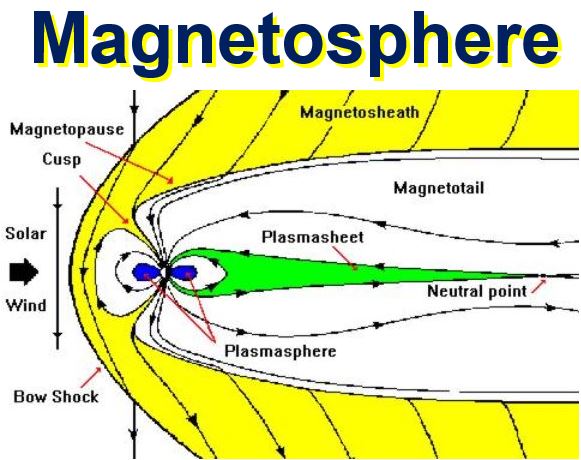A Sun superflare could destroy life on Earth, and not just completely frazzle our electronic equipment, says an international team of scientists. Those who say the Sun’s magnetic field is too weak for a superflare could be wrong – astronomers have detected superflares in stars with weaker magnetic fields.
If our Sun does have the capacity to produce a superflare, how frequently have they occurred? Recent calculations estimate that one is produced approximately every thousand years. The last one occurred in 775 AD or 1,241 years ago.
If these estimates are right, could it mean we are ripe for another one?
 If the Sun can produce superflares, it has the capacity to end life on Earth, scientists say. In this latest study, they say the Sun’s capacity to produce superflares cannot be ruled out. (Image: shtfplan.com)
If the Sun can produce superflares, it has the capacity to end life on Earth, scientists say. In this latest study, they say the Sun’s capacity to produce superflares cannot be ruled out. (Image: shtfplan.com)
A team of scientists from Denmark, China and Italy wrote in the journal Nature Communicaitons that they can now answer the question: “Are superflares formed by the same mechanism as solar flares, and if so, can our Sun produce a superflare?”
We know solar eruptions are common
Solar eruptions are common, with many of them affecting our planet. Solar eruptions are the result of a build up of energetic particles that are thrown out into space by the Sun. Many of them reach Earth, but do not hurt us because of our planet’s magnetosphere.
The magnetosphere is the region surrounding the Earth or other planet in which its magnetic field is the predominant effective magnetic field. According to NASA: “The magnetosphere prevents most of the particles from the Sun, carried by solar wind, from hitting the Earth. This asymmetrical region surrounds Earth, extending from about one hundred to several thousand kilometers (about 36,000 miles) above the surface.”
 While Earth’s magnetosphere protects us from solar eruptions, it would not be strong enough to withstand a strong superflare. (Image: helios.gsfc.nasa.gov)
While Earth’s magnetosphere protects us from solar eruptions, it would not be strong enough to withstand a strong superflare. (Image: helios.gsfc.nasa.gov)
When solar eruptions interact with Earth’s magnetic field, they produce spectacular light shows called auroras. Auroras are usually observed in the northern and southern hemispheres, far from the equator. In the northern hemisphere they are called aurora borealis (Northern Lights) – aurora australis (Southern Lights) are observed in the southern hemisphere.
These stunning auroras are a poetic reminder that our Sun is an unpredictable and very powerful star.
Superflares vs. solar eruptions
The consequences of solar eruptions, however, pale into insignificance when compared to the superflares observed outside our Solar System in other stars.
Superflares are the mega-beasts in the world of star surface explosions. A superflare can have up to ten thousand times the energy of a solar flare (solar eruption).
Since the Kepler space observatory was launched in 2009, scientists have learned a great deal about superflares. However, they still remain a mystery and there is much we do not yet know about them.
Nobody knew whether superflares were formed in the same way as solar flares, that is, until now. If they are produced in the same way, does that mean that our Sun has the capacity for superflares?
 If the Sun produces a superflare every thousand years, when will the next one come? (Image: https://theextinctionprotocol)
If the Sun produces a superflare every thousand years, when will the next one come? (Image: https://theextinctionprotocol)
Christoffer Karoff, Associate Professor, VILLUM Young Investigator at Aarhus University’s Department of Physics and Astronomy in Copenhagen, Denmark, and colleagues explain in the journal that they think they have the answer to those questions.
Our dangerous neighbour – the Sun
The Sun has the capacity to produce very large solar eruptions that disturb our radio communications and power supplies on Earth.
The Carrington Event, which occurred in 1859, was the largest solar eruption we know of in modern history. Huge quantities of hot plasma from the Sun reached Earth.
On 1st September 1859, astronomers noticed how one dark spot on the Sun’s surface suddenly shone ultra-brightly across its surface.
As this phenomenon had never been observed before, nobody knew what was to come. On 2nd September, the first particles, from what scientists today know was a huge eruption on the Sun’s surface, hit our planet.
Auroras linked to the Carrington Event could be seen as far south as Cuba and Hawaii, telegraph systems across the world were severely disrupted. According to ice core records from Greenland, the Earth’s protective ozone layer was damaged by the charged particles from the solar storm.
Some superflares are colossal
We know of stars out there in the Universe with superflares up to ten-thousand times bigger than the solar eruption that caused the Carrington Event.
A solar flare occurs when large magnetic fields on the Sun’s surface collapse. When this happens, huge quantities of magnetic energy are released.
Prof. Karoff and co-investigators have used observations of magnetic fields on the surface of approximately 100,000 stars made with the new Guo Shou Jing telescope, located in Xinglong Station, Hebei Province, China, to show that these superflares are most likely formed in same way as the Sun’s solar eruptions.
Regarding superflares and a star’s magnetic field, Prof. Karoff said:
“The magnetic fields on the surface of stars with superflares are generally stronger than the magnetic fields on the surface of the Sun. This is exactly what we would expect, if superflares are formed in the same way as solar flares.”
So, can the Sun produce superflares?
If superflares are associated with very strong magnetic fields, wouldn’t that mean that our Sun could not produce one?
Out of all the stars with superflares examined in this latest study, approximately 10% had magnetic fields either equal to or weaker than our Sun’s.
The scientists concluded that even though superflares from our Sun are unlikely, in theory it definitely has the capacity to produce them – or to put it another way ‘it is definitely not impossible.’
The authors made the following comment in an Abstract in the journal:
“However, superflare stars with activity levels lower than, or comparable to, the Sun do exist, suggesting that solar flares and superflares most likely share the same origin.”
Prof. Karoff said:
“We certainly did not expect to find superflare stars with magnetic fields as weak as the magnetic fields on the Sun. This opens the possibility that the Sun could generate a superflare – a very frightening thought.”
If the Sun produced a superflare, the consequences would be catastrophic for us. Not only would all our electronic equipment be completely knocked out, our atmosphere would change so much that it would become impossible for Earth to support life – all of us would die.
Has a superflare ever struck Earth?
Geological archives suggest that a superflare from the Sun hit our planet in 775 AD. According to tree-ring evidence, abnormally large quantities of radioactive isotope 14C were formed in Earth’s atmosphere.
Radiocarbon, or 14C, is formed when cosmic-ray particles from our galaxy (Milky Way), or especially-energetic protons from the Sun, formed in connection with major solar eruptions, make their way into the Earth’s atmosphere.
According to recent studies using the Guo Shuo Jing telescope, also known as Large Sky Area Multi-Object Fibre Spectroscopic Telescope (LAMOST), there was a superflare in 775 AD. It must have been a relatively small one, otherwise we would not be here to learn about it.
Scientists believe that superflare was between 10 and 100 times larger than any solar eruption observed during the space age.
Prof. Karoff said:
“One of the strengths of our study is that we can show how astronomical observations of superflares agree with Earth-based studies of radioactive isotopes in tree rings.”
The Sun could well have been producing one superflare every thousand years for millions of years, the scientists suggest.
Citation: “Observational evidence for enhanced magnetic activity of superflare stars,” Yonghui Hou, Yuefei Wang, Christoffer Karoff, Mads Faurschou Knudsen, Yong Zhang, Jianrong Shi, Peter De Cat, Alfio Bonanno, Antonio Frasca, Fadil Inceoglu, Alexandra Fogtmann-Schulz, Jianning Fu, Jesper Olsen & Wei Zhang. Nature Communications 7 – Article number: 11058. 24 March 2016. DOI: 10.1038/ncomms11058.
Video – A solar superflare: Need we worry?
